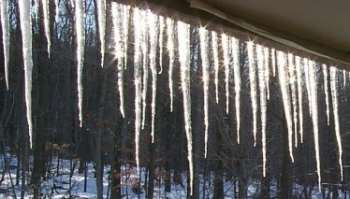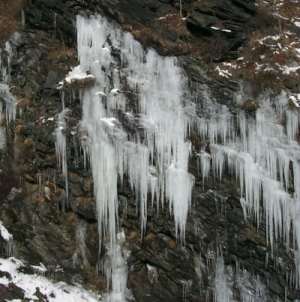 |
 |
| Home | Welcome | What's New | Site Map | Glossary | Weather Doctor Amazon Store | Book Store | Accolades | Email Us |
 | |||||||||||
IciclesTo simplify the discussion, I will consider the formation of icicles on roof edges, but their formation on other surfaces usually follows a similar process.  Photo courtesy of NOAA, US Department of Commerce. We'll start with a slanted roof having a snow cover. To initiate the icicle formation, the temperature of the snow must rise above its melting temperature. Strong solar heating of absorbing roof materials and internal heat loss from an improperly insulated attic or under-roof are prime agents for raising rooftop temperatures and causing snowmelt. When the snowmelt flows down the roof, the competition between gravity — pulling the water downward — and surface tension — trying to keep the water flow flat — leads to the formation of evenly-spaced ripples along the flow front. These ripples will freeze when and where the surface temperature dips below 0oC (32oF), and the frozen ripples become the icicle roots. Icicles then grow as water dripping over the roots freeze in progressive layers rather than being frozen all at once. This initiates icicle formation.
New icicles are typically cone-shaped, and often small bubbles can be seen within them. As they grow, vertical ridges and horizontal ribs, or rings, form on their outer surface. Icicles grow downward and outward simultaneously but at differing rates. After a period of continuous growth, icicles display prominent horizontal ribbing which encircles the icicle to form a series of progressively smaller rings toward the tip. Each ring is separated from those surrounding it by shallow constrictions in the ice. Typically, rings extend outward less than a centimetre (half an inch). During active icicle growth, the rings are initially composed of fragile, thin ice plates growing randomly outward, but the spaces between them are soon filled with downward flowing meltwater. Vertical ridges form during renewed growth after a period of dormancy. Melt water streams down the icicle exterior, initially laying a thin track of ice. Continued flow will add additional ice along the same track for as long as the track surface does not completely freeze. Tracks have widths approximately that of the meltwater stream percolating down the icicle. They can build ridges outward half a centimetre (a quarter inch) or more before the water shifts to another track. The tip of a growing icicle is primarily liquid water with a pendent drop on the tip end. Typically liquid water extends several centimetres (about an inch) up into the interior from the tip. The outer region of the tip is composed of randomly growing ice crystals which meld to form an elongated, inverted cup which is usually filled with liquid water. However, occasionally an air bubble will enter the cup and drain it of liquid. Water flowing along the exterior quickly restores the end drop, trapping some of that air and incorporating it into the solid icicle as a bubble several millimetres (tenths of inches) in diameter. Such bubbles can usually be seen located along the axis of the icicle, giving it a milky appearance. Even after active growth has stopped, the icicle will continue to change its shape and appearance, even at subfreezing temperatures. Some ice may sublime from solid water to the vapour state, thus slowly altering and smoothing the icicle's surface features. Although icicles can grow to several metres (yards) in length, eventually, melting or gravity will bring an end to the icicle, causing it to fall from its perch and crash onto the surface below. For home and building owners those tapering spikes of ice hanging down from roof edges are common winter problems. They can cause damage to the building since large icicles have the potential to pull down gutters. During thaws or wind storms, falling icicles can be extremely dangerous to people below. Icicles forming on or near waterfalls and other areas, where liquid water seeps from the rock or soil, add further beauty to natural winter scenes. In some cases, the spray from the falling water drifts onto existing icicles can form an extensive, intertwining network of merged ice and hanging spikes giving the appearance of an ice curtain.  Photo courtesy of NOAA, US Department of Commerce.
Learn More From These Relevant Books
|
|||||||||||
 |
To Purchase Notecard, |
Now Available! Order Today! | |
 |
 |
NEW! Now Available in the US! |
The BC Weather Book: |


